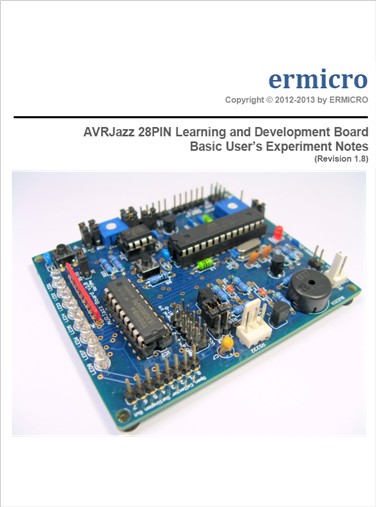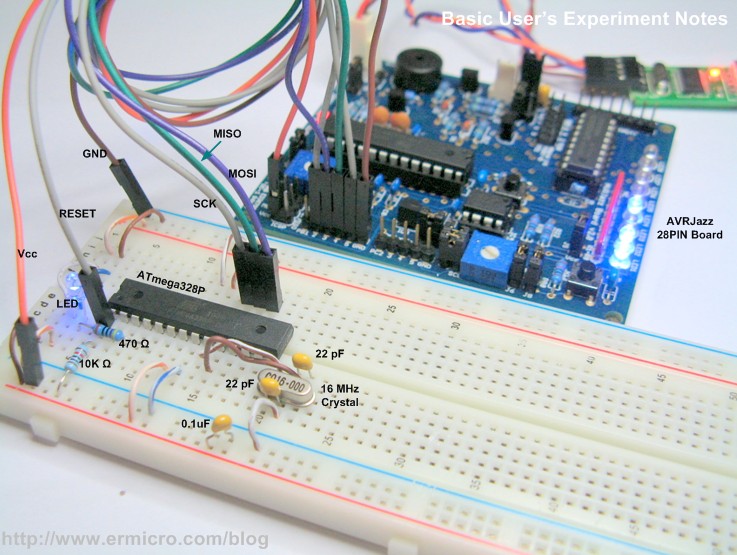e-Books
Basic User’s Experiment Notes
The “Basic User’s Experiment Note” is based on the popular 8-bit Atmel AVR ATmega328P microcontroller using AVRJazz 28PIN development board. This e-book covering most of the Atmel AVR ATmega328P microcontroller important features. With almost 140 pages, this e-book is organized similar to many of the ermicroblog’s project pages where it used many important information inside the Atmel AVR ATmega328P microcontroller datasheet to explained the experiments on each subject. The e-book is aimed for the beginners, hobbyist, or anyone who wants to learn and understand many of the 8-bit Atmel AVR ATmega328P microcontroller powerful features.
Chapter 1 – Introduction: this chapter is a short introduction to microcontroller world, the AVRJazz 28PIN development board from ermicro and the software needed to accomplish all the experiments on this e-book.
Chapter 2 – Hello World: this first chapter introduce the reader to use the latest Atmel AVR development tools AVR Studio 6, compiling and down loading the AVR C code into the AVR ATmega328P microcontroller flash RAM. Experiment Video: HellWorld.wmv
Chapter 3 – Blink LED: this chapter deals with manipulating the AVR ATmega328P microcontroller output port. Experiment Video: BlinkLED.wmv
Chapter 4 – Rotating LED: this chapter introduces how the AVR ATmega328P microcontroller read the digital input, process it and display the result to its output port. Experiment Video: RotatingLED.wmv
Chapter 5 – Analog to Digital: this chapter introduces of how the AVR ATmega328P microcontroller process the analog input using its ADC peripheral. Experiment Video: ADCRead.wmv
Chapter 6 – Reading Temperature: reading the Microchip MCP9700A precision centigrade temperature sensor and displaying the temperature output on the 8 LED. Experiment Video: TempRead.wmv
Chapter 7 – Serial Communication: using the AVR ATmega328P microcontroller UART feature, where you could send a command to the microcontroller from the PC using the PC terminal application.
Chapter 8 – Serial Data Logger: this chapter introduce to a powerful tools called “Processing” as human to machine interface (HMI) to plot a graph and recording an analog data transferred from the AVR ATmega328P microcontroller UART to the PC. Experiment Video: SerialRead.wmv
Chapter 9 – Timer and Interrupt: this chapter introduces the AVR ATmega328P microcontroller TIMER peripherals and the microcontroller interrupt concept. Experiment Video: AVRTimer.wmv
Chapter 10 – Pulsing with Timer: this chapter used the AVR ATmega328P microcontroller TIMER peripheral to generating pulse which is the basic concepts for controlling the many Servo motors simultaneously. Experiment Video: AVRpulse.wmv
Chapter 11 – Pulse Width Modulation (PWM): this chapter introduces of how to generate the Pulse Width Modulation (PWM) signal using the AVR ATmega328P microcontroller PWM peripheral. Experiment Video: AVRpwm.wmv
Chapter 12 – Generating Precision PWM Waveform: this chapter takes advantage of other PWM mode on the AVR ATmega328P microcontroller PWM peripheral. Experiment Video: AVRpcpwm.wmv
Chapter 13 – Generating Sound with PWM: this chapter introduces how to generate sound and play a sound note using the AVR ATmega328P microcontroller PWM peripheral. Experiment Video: AVRsound.wmv
Chapter 14 – Using the EEPROM: this chapter shows you how to store data in the AVR ATmega328P EEPROM. This chapter also show how to integrate “avrdude” the open source programmer application into the AVR Studio 6.0
Chapter 15 – Using I2C EEPROM: this chapter introduces how to use the AVR ATmega328P two wire or I2C (read as I Square C) peripheral to communicate with the Microchip 24AA128 I2C CMOS serial EEPROM. Experiment Video: AVRi2c.wmv
Chapter 16 – The Watchdog Timer: this chapter introduces the AVR ATmega328P microcontroller watchdog TIMER peripheral. Experiment Video: AVRwdog.wmv
Chapter 17 – Hello Arduino: this chapter shows how we could take advantage of one of the most popular AVR ATmega328P development framework environment named Arduino to program the AVRJazz 28PIN development board. Experiment Video: HelloArduino.wmv
Chapter 18 – Using I2C EEPROM with Arduino: example of using the Arduino I2C library to connect to the Microchip 24AA128 I2C CMOS serial EEPROM. This chapter is similar to project on Chapter 15 and could be used as code comparison between coding using standard C code and Arduino sketch.
Chapter 19 – Analog Comparator: take advantage of the AVR ATmega328P Analog Comparator peripheral to compare two analog inputs.
Chapter 20 – External Interrupt: use the AVR ATmega328P external Interrupt I/O features two read a digital input. Experiment Video: ReadKey.wmv
Chapter 21 – Power Management: this chapter shows how we could use the Atmel AVR ATmega328P microcontroller power management feature to reduce the overall power consumption.
Chapter 22 – AVR In-System Programmer: on this last chapter you will learn to turn the AVRJazz 28PIN development board into the AVR In-System Programmer to program another AVR ATmega328P microcontroller. In this chapter you also learn to build ATmega328P minimum system on breadboard and how to program a fresh AVR ATmega328P microcontroller fuse and lock bit and then downloaded the HEX code into its flash RAM. Experiment Video: ArduinoISP.wmv
Appendix A – Atmel AVR ATmega328P Minimum System: this is the extension of the chapter 22, where you could build the AVR ATmega328P microcontroller minimum system on breadboard in order to run many of the experiments presented in this note.
The exercises will be presented at the end of each chapter to broaden the topics learned. The e-book includes the entire Atmel AVR Studio 6 source project (C code) and the videos for some of the experiments (downloadable from the link address above). Although all the experiments in this e-book used the AVRJazz 28PIN development board from ermicro, but you could apply all the experiments in this e-book to any AVR ATmega328P microcontroller board.
This e-book is included (free) to any purchase of the AVRJazz 28PIN development board from ermicro. You could also purchase this e-book separately (include all the source project) for just USD 5 (five US Dollar). Please send your request to the ermicro sales.


